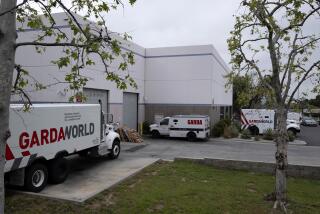Cow Ate the Cash? All Is Not Lost
- Share via
WASHINGTON — The cow story has become a legend around the Bureau of Engraving and Printing.
It seems a farmer lost his wallet while he was plowing a field. The farmer suspected his cow ate the wallet, so he had the beast slaughtered and sent the stomach to Washington with a request that the bureau retrieve the wallet and replace the damaged cash.
The story has a happy ending for the farmer, if not for the cow. Bureau examiners searched the cow’s stomach, found the wallet and mailed the man a check for $600.
It’s all in a day’s work for the folks who not only print the nation’s money but also are called upon to replace millions of dollars in damaged greenbacks each year.
“We always tell people to send their currency in the original container, but that’s not what we had in mind,” said Lorraine Robinson, division manager at the bureau’s Office of Currency Standards, of the cow incident, which happened in the 1970s.
Last year the Treasury agency replaced $82 million worth of badly damaged currency, involving 26,000 to 28,000 cases. The most common causes of damage are fire, water, chemicals, explosives, animals, insects and rodents. Problems also arise when currency deteriorates or petrifies when it is buried.
The bureau’s caseload often increases when there are natural disasters, such as the recent floods in the Midwest and the wildfires that ravaged some Western states last year.
The government has some rules for paying people the full value for damaged greenbacks. More than 50% of a note identified as genuine U.S. currency must be present, or 50% or less can be present as long as the Treasury is satisfied that the missing portions have been totally destroyed. Officials do that by looking at the method of mutilation and any supporting evidence.
“You can’t just say my cat, dog or child ate it and that’s it. That’s not going to satisfy us,” Robinson said. “We’ve had people wait until the cat deposited out the other end. We ask that you clean it up and we’ll take it. Otherwise, we’ll send it back to you.”
The Bureau of Engraving and Printing handles only cases involving currency and tends to deal with greenbacks in pretty bad shape. People with notes that are just dirty or worn should exchange them through a local bank. Damaged coins must be exchanged through the U.S. Mint, which has a similar program. Neither government agency charges people for replacing their cash.
People can deliver their damaged bills in person or mail them in. An armored truck picks up cartloads of envelopes and packages from the main post office here. They are opened, recorded and stored in a vault.
Then the painstaking work begins: Identifying something out of what might be fragments, piles of ashes or fused masses as genuine currency. That is the tedious and delicate job of 20 examiners.
“Sometimes it’s like figuring out a jigsaw puzzle,” said examiner Lorraine McGill, a 23-year veteran.
One of her most memorable cases, she said, involved money that had been found under an outhouse. The money reeked and had to sit in a special solution for months to be decontaminated before work could begin. “I was the lucky recipient of that one,” McGill recalled.
Cases are ranked on a scale of 1 to 6, with 6 being the most difficult. A “1” might be currency that was chewed, and a “6” might be currency that was burned to ashes, Robinson explained.
How can you identify anything from ash?
From the smallest scraps, examiners might be able to identify a fleck of printing or a picture or some other pattern, Robinson said. Most of the time, examiners can make sufficient identifications so that people get back some money. But if no identifications can be made, there is no replacement.
“If we picked up six left-hand corners of a $20 [bill], then we would count that as six twenties,” Robinson explained. “If we picked up four left-hand corners and four right-hand corners, the best we can do is give you the value of four notes.”
On some notes that are burned but have not been reduced to ash, it is possible to see printing and other surviving details.
McGill and her fellow examiners look like archeologists working at their desks, the tops of which are lined with brown paper. They have giant magnifying glasses, a variety of metal tools used to cut, scrape, poke and prod. Sometimes microscopes are used. Salvaged pieces of bills are carefully taped to strips of white tissue paper. All the desks have clear, hard plastic roll-tops that are locked when not in use.
Examiners are trained to identify patterns for each denomination, what’s counterfeit and specific techniques to deal with, for instance, burned money versus buried money.
After a case is closed, the currency is held for 45 days, then destroyed. The greenbacks are burned beyond recognition in a giant boiler on the premises that helps to heat and cool the building.
More to Read
Sign up for Essential California
The most important California stories and recommendations in your inbox every morning.
You may occasionally receive promotional content from the Los Angeles Times.













